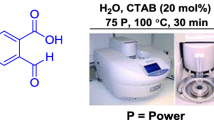Abstract
ective: The quinoline scaffold is widely acknowledged as a critical framework for the development of novel pharmaceuticals. The derivatives of quinoline have antifungal, antibacterial, antitumor, and anticancer effects. Over the past 30 years, bacterial and fungal infections have grown significantly. Developing new infectious illness treatments is a major issue. As antimicrobials, we produced substituted 2-chloroquinoline compounds. The antimicrobial screening shows moderate activities against used microbes. Methods: By employing microwave irradiation, 2-chloro-5,6-dimethyl-3-(((substituted-benzylidene)hydrazono)methyl)quinoline can be synthesized quickly and efficiently. One-pot reaction between (E)-2-chloro-3-(hydrazonomethyl)-7,8-dimethylquinoline and substituted Carbaldehyde in glacial acetic acid and MeOH as a solvent yields the anticipated outcome. Results and Discussion: The MIC of produced compounds was determined by broth dilution. All fifteen (I–XV) synthesized compounds were evaluated for their antibacterial and antifungal activity in vitro. Compounds (I–VII), (X–XIII), and (XIV) have greater antibacterial activity against Staphylococcus aureus and Streptococcus pyogenes Gram-positive bacteria, Compounds (IV), (VII), (XIII), (XIV), and (XV) have demonstrated effective antibacterial activity against Escherichia coli and Pseudomonas aeruginosa Gram-negative bacteria. Compounds (I), (IV), (V), and (XI) exhibited moderate antifungal activity against C. albicans, A. niger, and A. clavatus. Conclusions: A powerful one-pot approach has been designed to synthesize substituted quinolones. Microwave-assisted synthesis greatly accelerates reaction rate and reduces product impurityand shows modest in vitro antimicrobial and antifungal activity.




Similar content being viewed by others
DATA AVAILABILITY
The data that support the findings of this study are available from the corresponding author upon reasonable request.
REFERENCES
Horn, J., Marsden, S.P., Nelson, A., House, D., Weingarten, G., and Convergent, G., Org. Lett., 2008, vol. 10, pp. 4117–4120. https://doi.org/10.1021/ol8016726
Puskullu, O., Tekiner, M., and Suzen, S., Mini-Rev. Med. Chem., 2013, vol. 13, pp. 365–372. https://doi.org/10.2174/1389557511313030005
O’Loughlin, J., Kehrmeyer, R., and Sims, K., Int. Biodeter. Biodeg., 1996, vol. 38, pp. 107–118. https://doi.org/10.1016/S0964-8305(96)00032-7
Walle, T., Boone, M., Puyvelde, J., Combrinck, J., Smith, J., Chibale, K., Mangelinckx, S., and D’hooghe, M., Eur. J. Med.Chem., 2020, vol. 198, Article ID: 112330.
Musiol, R., Serda, M., Hensel-Bielowka, S., and Polanski, J., Curr. Med. Chem., 2010, vol. 17, pp. 1960–1973. https://doi.org/10.2174/092986710791163966
Panda, P., and Subhendu, C., ChemistrySelect, 2020, vol. 5, pp. 10187–10199. https://doi.org/10.1002/slct.202002790
Taha, M., Sadia, S., Syahrul, I., Fazal, R., Khalid, Z., Abdul, W., Ashfaq, R., Nizam, U., and Khalid, K., Bioorg. Med. Chem., 2019, vol. 18, pp. 4081–4088. https://doi.org/10.1016/j.bmc.2019.07.035
Kouznetsov, V.V., Leonor, Y., Vargas, M., Carlos, E., Puerto, G., and Marlyn, C., and Ortiz, V., New J. Chem., 2020, vol. 1, pp. 12–19.
Nagargoje, Amol A., Satish, A., Madiha, S., Dnyaneshwar, S., Jaiprakash, S., Vijay, K., and Bapurao, S., Chem. Biodivers., 2020, vol. 2, pp. e1900624–e1900820.
Weyesa, A. and Endale, M., RSC Adv., 2020, vol. 35, pp. 20784–20793. https://doi.org/10.1039/d0ra03763j
Ramprasad, J., Vinay, S., Rama Linga, T., Supriya, B., Ramesh, U., Sridhar, B., and Srihari, P., Bioorg. Med. Chem. Lett., 2020, vol. 20, Article ID: 126671.
Insuasty, D., Oscar, V., Anthony, B., Edgar, M., Juan, G., Braulio, I., Jairo, Q., Antibiotics, 2019, vol. 4, p. 239. https://doi.org/10.3390/antibiotics8040239
Yadav, V., Jurnal, R., Vinita, S., Jaseela, M., Sharma, P., Sharma, K., Giri, N., Kumar, A., and Tonk, R., Chem. Bio. Drug. Des., 2022, vol. 100, pp. 389–418. https://doi.org/10.1111/cbdd.14099
Awolade, P., Cele, N., Kerru, N., and Singh, P., Mol. Divers., 2021, vol. 25, pp. 2201–2218. https://doi.org/10.1007/s11030-020-10112-3
El-Shershaby, Mohamed, H., El-Gamal, K.M., Bayoumi, A., El-Adl, K., Alswah, M., EA Ahmed, H., Al-Karmalamy, A., and Abulkhair, H., New J. Chem., 2021, vol. 45, pp. 13986–14004. https://doi.org/10.1039/D1NJ02838C
Elgawad, A., Hanan, Alhusseiny, S., Taman, A., Youssef, M., Mansour, B., Massoud, M., and Handousa, A., Exp. Parasitol., 2019, vol. 206, Article ID: 107756. https://doi.org/
Khan, Salman, A., Asiri A., Basisi, H., Asad, M., Zayed, M., Sharma, K., and Wani, M., Bioorg. Chem., 2019, vol. 88, Article ID: 102968. https://doi.org/10.1016/j.bioorg.2019.102968
Katariya, D., Shah, S., and Reddy, D., Bioorg. Chem., 2020, vol. 94, Article ID: 103406. https://doi.org/10.1016/j.bioorg.2019.103406
Kayamba, F., Malimabe, T., Ademola, I., Pooe, O., Kushwaha, N., Mahlalela, M., and Robyn, L., Eur. J. Med. Chem., 2021, vol. 217, Article ID: 113330. https://doi.org/10.1016/j.ejmech.2021.113330
Orozco, Dayana, Kouznetsov, V., Bermúdez, A., Méndez, L., Salgado, A., and Gómez, C., RSC Adv., 2020, vol. 10, pp. 4876–4898. https://doi.org/10.1039/C9RA09905K
Liu, J., Dan, B., Chen, Y., Wen, S., and Cheng, G., Chem. Commun., 2020, vol. 56, pp. 4078–4081. https://doi.org/10.1039/C9CC09460A
Martorana, A., Monica, G., and Lauria, A., Molecules, 2020, vol. 25, Article ID: 4279. https://doi.org/10.3390/molecules25184279
Dorababu, A., ChemistrySelect, 2020, vol. 44, pp. 13902– 13915. https://doi.org/10.1002/slct.202003888
Moor, L.E., Vasconcelos, T., Reis, R., Pinto, L., and Costa, T., Mini-Rev. Med. Chem., 2021, vol. 21, pp. 2209– 2226. https://doi.org/
Reddyrajula, R. and Dalimba, U., ChemistrySelect, 2019, vol. 9, pp. 2685–2693. https://doi.org/10.1002/slct.201803946
Pradeep, M., Vishnuvardhan, M., and Thalari, G., Chem. Data Coll., 2021, vol. 32, Article ID: 100666. https://doi.org/10.1016/j.cdc.2021.100666
ACKNOWLEDGMENTS
The Department of Chemistry at Saurashtra University, Rajkot, India, and the Centre of Excellence (CoE), NFDD Complex, Rajkot, India, who provided the laboratory space and spectral data, respectively, are gratefully acknowledged by the authors.
Funding
The funding for this work was supported by the institution’s regular resources, and no further grants were acquired.
Author information
Authors and Affiliations
Contributions
The author NKV contributed to the writing and compilation processes of the manuscript and selected the literature data pertinent to the review topic under supervision of authors HSJ, KK, and TDB both made contributions to the literature study. Every author was present during the discussions.
Corresponding author
Ethics declarations
This article does not contain any studies involving patients or animals as test objects. Informed consent was not required for this article. No conflict of interest was declared by the authors.
Additional information
Publisher's Note. Pleiades Publishing remains neutral with regard to jurisdictional claims in published maps and institutional affiliations.
Supplementary information
Rights and permissions
About this article
Cite this article
Vegal, N.K., Bhatt, T.D., Kachhot, K. et al. Effective Microwave-Assisted Synthesis of 2-Chloro-5,6-dimethyl-3-(((substituted-benzylidene)hydrazono)methyl)-quinoline and Its Biological Assessment. Russ J Bioorg Chem 50, 239–250 (2024). https://doi.org/10.1134/S1068162024010254
Received:
Revised:
Accepted:
Published:
Issue Date:
DOI: https://doi.org/10.1134/S1068162024010254



